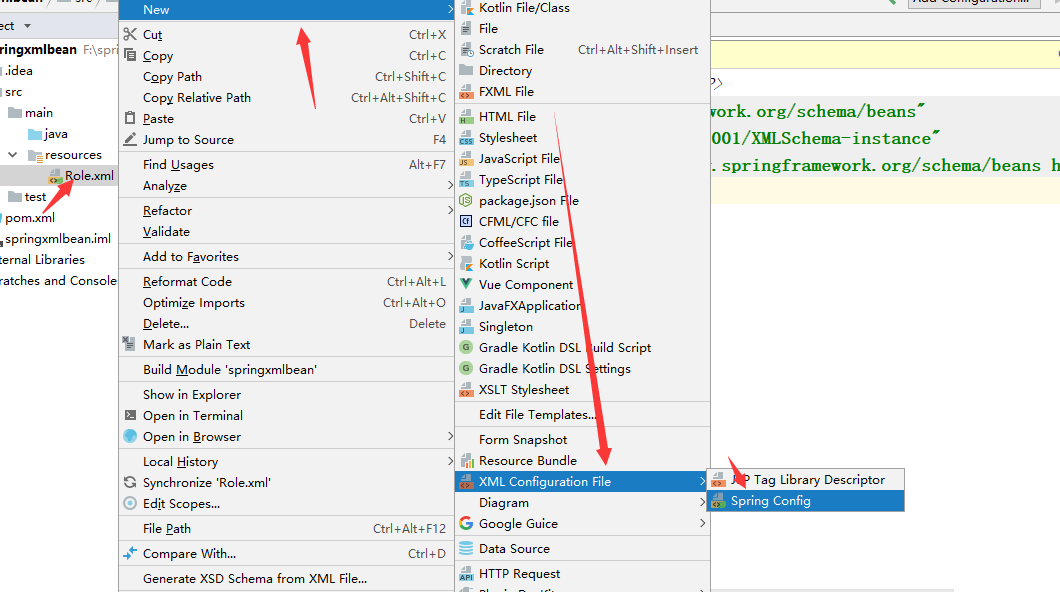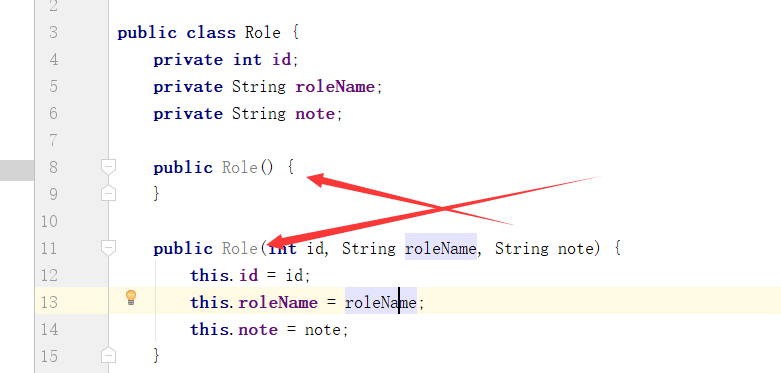Spring 通过XML配置装配Bean
使用XML装配Bean需要定义对于的XML,需要引入对应的XML模式(XSD)文件,这些文件会定义配置Spring Bean的一些元素,简单的配置如下:
<?xml version="1.0" encoding="UTF-8"?>
<beans xmlns="http://www.springframework.org/schema/beans"
xmlns:xsi="http://www.w3.org/2001/XMLSchema-instance"
xsi:schemaLocation="http://www.springframework.org/schema/beans http://www.springframework.org/schema/beans/spring-beans.xsd"> </beans>

创建角色类Role
类构造器有参与无参
代码:
Role:
package com.wbg.springxmlbean.entity;
public class Role {
private int id;
private String roleName;
private String note;
@Override
public String toString() {
return "Role{" +
"id=" + id +
", roleName='" + roleName + '\'' +
", note='" + note + '\'' +
'}';
}
public Role() {
}
public Role(int id, String roleName, String note) {
this.id = id;
this.roleName = roleName;
this.note = note;
}
public int getId() {
return id;
}
public void setId(int id) {
this.id = id;
}
public String getRoleName() {
return roleName;
}
public void setRoleName(String roleName) {
this.roleName = roleName;
}
public String getNote() {
return note;
}
public void setNote(String note) {
this.note = note;
}
}
User:
package com.wbg.springxmlbean.entity;
public class User {
private int id;
private Role role;
@Override
public String toString() {
return "User{" +
"id=" + id +
", role=" + role +
", name='" + name + '\'' +
", age=" + age +
'}';
}
public Role getRole() {
return role;
}
public void setRole(Role role) {
this.role = role;
}
public int getId() {
return id;
}
public void setId(int id) {
this.id = id;
}
public String getName() {
return name;
}
public void setName(String name) {
this.name = name;
}
public int getAge() {
return age;
}
public void setAge(int age) {
this.age = age;
}
private String name;
private int age;
}

xml进行配置:
1、装备简易值
<!--
id:属性是Spring找到的这个Bean的编号,不是必须的,如果没有Spring会采用:
"全限定名#{number}"的格式生成编号
列如: <bean class="com.wbg.springxmlbean.entity.Role">
Spring会生成编号为:"com.wbg.springxmlbean.entity.Role#1"
class:是一个类的全限定名
-->
<bean id="role1" class="com.wbg.springxmlbean.entity.Role">
<!-- property元素是定义类的属性,name属性定义的是属性名称 value是值
相当于:
Role role=new Role();
role.setId(1);
role.setRoleName("高级工程师");
role.setNote("重要人员");-->
<property name="id" value="1"/>
<property name="roleName" value="高级工程师"/>
<property name="note" value="重要人员"/>
</bean>
<bean id="rolew" class="com.wbg.springxmlbean.entity.Role">
<!-- constructor-arg元素,index代表参数索引, value是值
相当于:
Role role=new Role(1,"高级工程师","重要人员");-->
<constructor-arg index="0" value="1"/>
<constructor-arg index="1" value="高级工程师"/>
<constructor-arg index="2" value="重要人员"/>
</bean>
<bean id="user" class="com.wbg.springxmlbean.entity.User">
<property name="id" value="1"/>
<property name="age" value="18"/>
<property name="name" value="韦邦杠"/>
<!--name是属性名称 ref是对应的Bean-->
<property name="role" ref="role1"/>
</bean>
测试:
public static void main(String[] args) {
ApplicationContext applicationContext=new ClassPathXmlApplicationContext("Role.xml");
UserService userService= (UserService) applicationContext.getBean("userService");
userService.setUser((User)applicationContext.getBean("user"));
System.out.println(userService.getUser());
}

2、装配集合
定义类:
package com.wbg.springxmlbean.entity;
import java.util.*;
public class ComplexAssembly {
private Long id;
private List<String> list;
private Map<String,String> map;
private Properties properties;
private Set<String> set;
private String[] array;
@Override
public String toString() {
return "ComplexAssembly{" +
"id=" + id +
", list=" + list +
", map=" + map +
", properties=" + properties +
", set=" + set +
", array=" + Arrays.toString(array) +
'}';
}
public Long getId() {
return id;
}
public void setId(Long id) {
this.id = id;
}
public List<String> getList() {
return list;
}
public void setList(List<String> list) {
this.list = list;
}
public Map<String, String> getMap() {
return map;
}
public void setMap(Map<String, String> map) {
this.map = map;
}
public Properties getProperties() {
return properties;
}
public void setProperties(Properties properties) {
this.properties = properties;
}
public Set<String> getSet() {
return set;
}
public void setSet(Set<String> set) {
this.set = set;
}
public String[] getArray() {
return array;
}
public void setArray(String[] array) {
this.array = array;
}
}
xml:
<bean id="complexAssembly" class="com.wbg.springxmlbean.entity.ComplexAssembly">
<property name="id" value="1"/>
<property name="list">
<!--List属性对应list元素进行装配,然后通过多个value设值-->
<list>
<value>value-list-1</value>
<value>value-list-2</value>
<value>value-list-3</value>
<value>value-list-4</value>
</list>
</property>
<property name="map">
<!--Map属性对应map元素进行装配,然后通过多个entry设值,只是entry包含有key和value值设值-->
<map>
<entry key="key1" value="value1"/>
<entry key="key2" value="value2"/>
<entry key="key3" value="value3"/>
<entry key="key4" value="value4"/>
</map>
</property>
<property name="properties">
<!--Properties属性,对应props进行装配,然后通过prop元素数值,只是prop有一个必填的key,然后设值-->
<props>
<prop key="prop1">value-prop-1</prop>
<prop key="prop2">value-prop-2</prop>
<prop key="prop3">value-prop-3</prop>
<prop key="prop4">value-prop-4</prop>
</props>
</property>
<property name="set">
<!--Set属性对应set元素进行装配,然后通过多个value设值-->
<set>
<value>value-set-1</value>
<value>value-set-2</value>
<value>value-set-3</value>
<value>value-set-4</value>
</set>
</property>
<property name="array">
<!--Array属性对应array元素进行装配,然后通过多个value设值-->
<array>
<value>value-array-1</value>
<value>value-array-2</value>
<value>value-array-3</value>
<value>value-array-4</value>
</array>
</property>
</bean>
测试:
ApplicationContext applicationContext=new ClassPathXmlApplicationContext("Role.xml");
ComplexAssembly complexAssembly= (ComplexAssembly) applicationContext.getBean("complexAssembly");
System.out.println(complexAssembly);

3、装配用户和角色
类:MapUserRole
package com.wbg.springxmlbean.entity;
import java.util.Map;
public class MapUserRole {
private Map<User,Role> map;
@Override
public String toString() {
return "MapUserRole{" +
"map=" + map +
'}';
}
public Map<User, Role> getMap() {
return map;
}
public void setMap(Map<User, Role> map) {
this.map = map;
}
}
xml:
<bean id="u2" class="com.wbg.springxmlbean.entity.User">
<property name="id" value="1"/>
<property name="name" value="小邦哥"/>
<property name="age" value="20"/>
</bean>
<bean id="u1" class="com.wbg.springxmlbean.entity.User">
<property name="id" value="2"/>
<property name="name" value="邦杠"/>
<property name="age" value="21"/>
</bean>
<bean id="r1" class="com.wbg.springxmlbean.entity.Role">
<constructor-arg index="0" value="1"/>
<constructor-arg index="1" value="中级工程师"/>
<constructor-arg index="2" value="普通人员"/>
</bean>
<bean id="r2" class="com.wbg.springxmlbean.entity.Role">
<constructor-arg index="0" value="2"/>
<constructor-arg index="1" value="高级工程师"/>
<constructor-arg index="2" value="重要人员"/>
</bean>
<bean id="mapUserRole" class="com.wbg.springxmlbean.entity.MapUserRole">
<property name="map">
<map>
<entry key-ref="u1" value-ref="r1"/>
<entry key-ref="u2" value-ref="r2"/>
</map>
</property>
</bean>
测试:

demo:https://github.com/weibanggang/springXmlBean
Spring 通过XML配置装配Bean的更多相关文章
- Spring基础篇——通过Java注解和XML配置装配bean
自动化装配的确有很大的便利性,但是却并不能适用在所有的应用场景,比如需要装配的组件类不是由自己的应用程序维护,而是引用了第三方的类库,这个时候自动装配便无法实现,Spring对此也提供了相应的解决方案 ...
- Spring基础篇——通过Java注解和XML配置装配bean(转载)
作者:陈本布衣 出处:http://www.cnblogs.com/chenbenbuyi 本文版权归作者和博客园共有,欢迎转载分享,但必须保留此段声明,且在文章页面明显位置给出原文链接,否则保留 ...
- Spring实战3:装配bean的进阶知识
主要内容: Environments and profiles Conditional bean declaration 处理自动装配的歧义 bean的作用域 The Spring Expressio ...
- Spring实战2:装配bean—依赖注入的本质
主要内容 Spring的配置方法概览 自动装配bean 基于Java配置文件装配bean 控制bean的创建和销毁 任何一个成功的应用都是由多个为了实现某个业务目标而相互协作的组件构成的,这些组件必须 ...
- Spring框架(3)---IOC装配Bean(注解方式)
IOC装配Bean(注解方式) 上面一遍文章讲了通过xml来装配Bean,那么这篇来讲注解方式来讲装配Bean对象 注解方式需要在原先的基础上重新配置环境: (1)Component标签举例 1:导入 ...
- spring+mybaits xml配置解析----转
一.项目中spring+mybaits xml配置解析 一般我们会在datasource.xml中进行如下配置,但是其中每个配置项原理和用途是什么,并不是那么清楚,如果不清楚的话,在使用时候就很有可能 ...
- spring的xml配置声明以及相应的问题处理
spring的xml配置声明: xml配置声明 Code 问题处理 问题1 xml报错: cvc-elt.1: Cannot find the declaration of element 'bea ...
- spring中用xml配置构造注入的心得
spring中用xml配置构造注入时,如果 <constructor-arg> 属性都是 ref ,则不用理会参数顺序 <constructor-arg ref="kill ...
- Spring框架(2)---IOC装配Bean(xml配置方式)
IOC装配Bean (1)Spring框架Bean实例化的方式提供了三种方式实例化Bean 构造方法实例化(默认无参数,用的最多) 静态工厂实例化 实例工厂实例化 下面先写这三种方法的applicat ...
随机推荐
- IntelliJ IDEA 安装配置
之前一直用的eclipse,以前公司的老大推荐过用这个,但是由于项目都比较赶,没及时学习. 后面这个公司的同时都用的idea,所以就换了 其实并没有那么难主要是刚刚切换时候快捷键不熟悉,打包什么的,有 ...
- AtomicInteger关键字
validate 关键字可以保证多线程之间的可见性,但是不能保证原子操作.(需要了解java内存模型jmm) package com.cn.test.thread; public class Vola ...
- EasyUI datebox 日期范围 日期关联
jQuery EasyUI 1.4.5 html: <label>提交日期:</label> <input id="startDate" name=& ...
- Tips——App启动速度的优化与监控
一.App的启动模式 冷启动:App点击启动前,它的进程不在系统里,需要系统新创建一个进程分配给它启动的情况.这是一次完整的启动过程. 热启动:App在冷启动后用户将App退后台,在App的进程还在系 ...
- ubuntu 16.10安装nginx
1 : cd /usr/local 2 : sudo wget http://nginx.org/download/nginx-1.2.8.tar.gz 3 : sudo tar -zxvf ngin ...
- 深入理解javascript原型和闭包_____全部
http://www.cnblogs.com/wangfupeng1988/p/3977924.html
- echarts 表格与 div 之间 空白的设置
一. options 图表选项,包含图表实例任何可配置选项: 公共选项 , 组件选项 , 数据选项 {Object} grid 二. grid 直角坐标系内绘图网格 名称 默认值 描述 {number ...
- 三重for循环实现对二维数组的按列排序(JavaScript)
由C语言联想到的:三重for循环实现对二维数组的按列排序,并且牵扯到数据结构. 自己写的,水平有限,本文属于原创,可能存在错误,忘指正~ function circle() { var a = [ [ ...
- Linux 虚拟机虚拟网卡问题导致无法连接问题
问题描述 当 Linux 虚拟机启动时,通过串口输出或者启动日志, 观察到虚拟网卡启动或者初始化故障, 导致虚拟机无法连接. 问题分析 常见的超时报错范例如下: CentOS 复制 Bringing ...
- [问题记录]libpomelo编译报错:ssize_t重定义
1. 时间:2015/01/16 描述:添加libpomelo到cocos2dx项目,报错如下图所示: 解决: 修改代码,源代码: #if !defined(_SSIZE_T_) && ...
